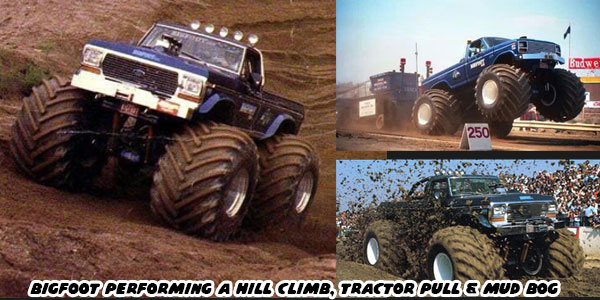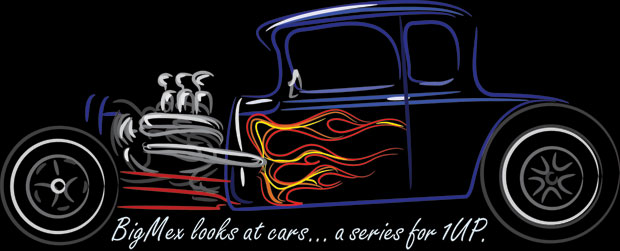I wasn't fortunate enough to have lived through the early hot rod era. My only exposure to those pioneers and their radical rides came from model kits and Hot Wheels. Sometimes I'd catch a car show on TV or see the rare rod on the street. Still, I longed for the days of do-it-yourself car culture. Where mechanics were breaking new ground and creating cars that were unlike anything before. Where the horsepower was in excess and the rods were making a real statement. I thought those days were long gone, especially during the era of Le Car. But in the midwest there was something brewing. The big city boys had their day in the sun and those in the heartland were making advances on their own time.
The mechanics on the farms didn't have the luxury of perfectly paved roads or a cruising scene. They, like most guys, were still drawn to the call of horsepower. The heartland was not without its own variation of D-I-Y hot rod culture. So they began tinkering and modifying their own rides or farm equipment. The natural tendencies towards competition led to the creation of the tractor pull. A contest where dragster-like horsepower was harnessed to have the tractors dig into the soft earth and pull a weighted sled the furthest distance. This was a show of power rather than a contest of speed. The modern tractor pull contests started around the same time as hot rods were warping the minds of pop culture. Rules, classes of tractors and distances were agreed upon leading to the formation of a National Tractor Pullers Association, a contemporary to the National Hot Rod Association. The tractors would begin mutating and becoming freaks with multiple engines, bright graphics and sponsors. In a way they looked like stocky cousins of dragsters, made big and strong by working on the farm while their slim big city cousins got all the attention. It was the subsequent innovation to hot rodding that caught the world's attention.

For those that lived in the hills horsepower was better put to use in making trucks and buggies that could crawl through the mud, climb over rocks and still get people to work. The D-I-Y mentality went into making rides with plenty of horsepower, greater ground clearance, a tighter turning radius and large tires that when combined made a statement to counter the low-slung rods of the west coast. At car shows and tractor pulls these modified trucks would show off for the crowd. Mechanics would try to find ways to one-up each other. Trucks with bigger engines, tilting cabs, wild suspensions or some other gimmick. The man that would become a god to young boys all across the USA was named Bob Chandler. His truck was named Bigfoot.
Before it became a legend it was one of those trucks shown off at tractor pulls. It ran courses of mud bogs and tractors pulls at the shows. It had large tires but not the massive ones. It did have a powerful racing engine that made it a threat on the street as much as off road. It even featured a unique double steering mechanism so that the driver could rotate both axles and turn super tight or even crawl along almost sideways in a "crab walk." Bob labeled his innovative truck a 4x4x4. There were imitators already following closely behind. People loved the truck already but it was a promotional video that Bob and his wife put together for their 4x4 shop that really got people talking. To show off the climbing ability of his truck and differentiate it from the rest he drove over some cars a few times. This was more than show of horsepower, it was an atom bomb on the collective car-loving consciousness.
The news spread quickly. There was a truck, a "monster" truck that could destroy and car it came across. This truck became a sensation at tractor pulls and car shows. In 1983 the Silverdome was packed to capacity to see the legend perform something which had only been seen on tape. Chandler swapped out the regular off road tires for massive 66-inch Firestone tires. The crowd was on its feet. The air was charged with electricity, as if 60,000 fans thought they would witness the impossible. Bigfoot edged up to some junkers and thousands of flashbulbs went off at the historic first public showing of a car crush. The world would never be the same. Bigfoot went on to celebrity status, eventually becoming an institution. Chandler lead the curve, making subsequent generations of Bigfoot trucks bigger, better or faster than the previous.

The era of the monster truck arrived and imitators came out overnight, each with their own nickname and gimmick. Some were larger, had engines pulled from aircraft, bodies made of sports cars, could crush buses... you get the idea. The first generation of monster trucks, the stars of the 80's were arguably the most memorable. They all had an incredible D-I-Y feel about them as no two monster trucks looked the same. Each brought a different interpretation of what a monster truck should be to the venues. When they moved the earth shifted underneath them. When they crushed cars it was slow and methodical, as if the cars were being punished by the gods. It was a show of brute force that had no equal. The type of show that young boys adored, the type of show that made them want to grow up and make a monster truck out of the family car.
The owners were usually also the drivers and mechanics that put them together. Each builder taking their own approach to suspension, engine, transmission and safety equipment. All carefully protecting their secrets. Echoing the first generation of hot rod builders and their early dragsters. These monsters had a supernatural air about them. The car crush was the first format of monster truck racing. It seemed that car crushing wasn't enough to slow down these beasts so promoters began inventing new formats of racing, each more spectacular than the last. Contests became hybrid tractor pull, car crush and mud bog contests. Even multiple obstacles didn't slow down the trucks. Popular culture was smitten by the monster truck bug. For the first time in a long while those in the city began emulating their country cousins. The monster truck would turn up in movies and make cheesy cameos on TV. All of this exposure would only serve to signal the end-times of the classic monster truck.

Money follows popular trends. This leads to advances in the culture. Years before sponsorship money made dragsters get lighter, go faster and be much safer. Dragsters were no longer whittled down from the frames of cars but instead being build by welding steel tubes together. The days of the owner, builder, racer were passing and teams of dedicated specialists were put together. Something similar happened with monster trucks. The trucks were becoming lighter, faster, stronger and safer thanks to sponsorship money. Trucks were built from steel tubing rather than stock frames. Bodies were molded in fiberglass and suspensions were rivaling the best pro off road race trucks. To me this was when the monster truck had lost its magic, its connection to the hot rod world. They had become more Travis Pastrana and less Evel Knievel, very stunt oriented without a hint of daredevil. The modern trucks were all tube frames and fiberglass shells, cookie-cutter trucks that could be dolled up for a sponsor. A paint job was the only thing that made them different. These trucks now prance and jump over cars and obstacles rather than really grinding them into the Earth. The monster truck had come of age but their owners, drivers and builders would come at odds with each other. When fame and money were involved then ego became the biggest failing to the monster truck.

In the early days of drag racing big money and big egos made for some splits within the community. Who should be paid and what amounts. Ticket sales, concessions and venue should all go to property owners? What about sponsorship at the tracks and rival companies? Would team owners receive the lions share of money or would drivers or mechanics see fair compensation? Not everybody came to an agreement so hot rod and by default drag racing associations were splintered groups such as the International Hot Rod Association and the National Street Rod Association. One of the oldest hot rod groups actually took control of and the organization of early monster truck races. The United States Hot Rod Association pretty much dropped it's hot rod legacy and became the Monster Jam venue. Saying that rival the National Hot Rod Association didn't understand the unique nature of tractor pulls, mud bogs and monster trucks. Even other monster truck groups began organizing such as the Major League of Monster Trucks and the Monster Truck Racing Association. Each claiming to represent real monster truck racing.
By the time this happened I had walked away from the scene. Politics and the changing public tide had taken my beloved monster trucks. There was little to console me as the gaming scene had rarely been kind to the genre. Tomorrow I'll talk about the monster truck games that were almost good.


No comments:
Post a Comment